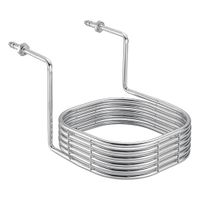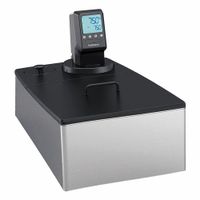Call +(254) 703 030 000 / 751 483 999 / 721 704 777
- Home
- Lab Supplies
- Lab Equipment
- Lab Circulators Water Baths
.....Read More
Frequently Asked Questions
What is the difference between a lab circulator and a water bath?
A lab circulator and a water bath are both used to maintain precise temperature control in laboratory settings, but they differ in functionality and application.
A lab circulator is a device that heats or cools a fluid, typically water or oil, and circulates it through an external system or a closed loop. It consists of a heating or cooling element, a pump, and a reservoir. The circulator provides uniform temperature distribution and is ideal for applications requiring precise temperature control and stability. It is often used in conjunction with other equipment, such as reactors or viscometers, where consistent temperature is crucial. Lab circulators can also offer a wider temperature range and faster temperature changes compared to water baths.
A water bath, on the other hand, is a container filled with heated water used to incubate samples at a constant temperature. It is simpler in design, typically consisting of a tank with a heating element and a thermostat to maintain the desired temperature. Water baths are commonly used for applications like warming reagents, melting substrates, or incubating cell cultures. They provide gentle, even heating but lack the ability to circulate fluid, which can lead to temperature gradients within the bath. Water baths are generally more cost-effective and easier to use for basic heating tasks.
In summary, the main difference lies in the circulation capability and temperature precision. Lab circulators offer precise temperature control and fluid circulation, making them suitable for complex applications, while water baths provide basic, even heating for simpler tasks.
How do you maintain the temperature in a lab circulator?
To maintain the temperature in a lab circulator, follow these steps:
1. **Set Desired Temperature**: Use the control panel to set the desired temperature. Ensure the setpoint is appropriate for your application.
2. **Check Fluid Levels**: Ensure the circulator is filled with the appropriate thermal fluid. The fluid should be compatible with the temperature range and the materials of the circulator.
3. **Ensure Proper Insulation**: Make sure the circulator and any connected equipment are properly insulated to minimize heat loss or gain.
4. **Monitor Temperature Stability**: Use built-in sensors or external thermometers to continuously monitor the temperature. Ensure the circulator maintains the set temperature within the required tolerance.
5. **Regular Calibration**: Periodically calibrate the temperature sensors and control systems to ensure accuracy.
6. **Maintain Cleanliness**: Keep the circulator and its components clean to ensure efficient heat transfer and prevent contamination.
7. **Check for Leaks**: Regularly inspect the system for leaks, which can affect temperature control and fluid levels.
8. **Use a Lid or Cover**: If applicable, use a lid or cover to reduce evaporation and heat loss.
9. **Adjust Flow Rate**: Ensure the flow rate is set correctly for optimal heat exchange. Too high or too low flow rates can affect temperature stability.
10. **Regular Maintenance**: Follow the manufacturer’s maintenance schedule for components like pumps, heaters, and sensors to ensure they function correctly.
11. **Environmental Control**: Maintain a stable ambient environment around the circulator to prevent external temperature fluctuations from affecting the system.
12. **Alarm Systems**: Utilize alarm systems to alert you of any deviations from the set temperature, allowing for quick corrective actions.
What fluids can be used in a lab water bath?
In a laboratory water bath, the choice of fluid depends on the required temperature range and the chemical compatibility with the materials being used. Common fluids include:
1. **Water**: Used for temperatures ranging from ambient to about 100°C. It is the most common and cost-effective fluid for general purposes.
2. **Distilled Water**: Preferred over tap water to prevent mineral deposits and contamination, especially in sensitive experiments.
3. **Deionized Water**: Used to avoid ionic contamination, particularly in experiments sensitive to ions.
4. **Ethylene Glycol-Water Mixture**: Suitable for temperatures below 0°C, as it lowers the freezing point. Commonly used in a 50:50 ratio for sub-zero applications.
5. **Propylene Glycol-Water Mixture**: Similar to ethylene glycol but less toxic, used for low-temperature applications.
6. **Silicone Oil**: Used for high-temperature applications, typically up to 200°C or more, due to its stability and low volatility.
7. **Mineral Oil**: Suitable for temperatures above 100°C, providing a stable medium for heating.
8. **Glycerol**: Used for temperatures up to about 150°C, offering a higher boiling point than water.
9. **Alcohols (e.g., Methanol, Ethanol)**: Used for low-temperature applications, but with caution due to flammability.
10. **Specialized Heat Transfer Fluids**: These are commercially available fluids designed for specific temperature ranges and applications, offering enhanced thermal stability and safety.
When selecting a fluid, consider factors such as the required temperature range, the chemical compatibility with the bath and samples, safety (toxicity and flammability), and cost. Always follow manufacturer guidelines and safety data sheets for handling and disposal.
How do you clean and maintain a lab water bath?
To clean and maintain a lab water bath, follow these steps:
1. **Turn Off and Unplug**: Ensure the water bath is turned off and unplugged from the power source to prevent electrical hazards.
2. **Drain the Water**: Carefully drain the water from the bath. Use a siphon or the built-in drain, if available, to remove all water.
3. **Remove Debris**: Use a soft cloth or sponge to remove any debris or sediment from the bottom and sides of the bath.
4. **Clean the Interior**: Prepare a mild detergent solution or use a specialized lab cleaner. Avoid harsh chemicals that could damage the bath. Use a soft brush or cloth to scrub the interior surfaces gently.
5. **Rinse Thoroughly**: Rinse the bath thoroughly with distilled water to remove any soap or cleaner residues.
6. **Descale if Necessary**: If there is mineral buildup, use a descaling agent recommended by the manufacturer. Follow the instructions carefully to avoid damage.
7. **Dry the Bath**: Wipe the interior with a clean, dry cloth. Allow the bath to air dry completely to prevent mold or mildew growth.
8. **Clean the Exterior**: Wipe down the exterior with a damp cloth and mild detergent. Avoid getting water into any electrical components.
9. **Inspect and Replace Parts**: Check for any wear or damage to parts like gaskets or seals. Replace them if necessary to ensure proper function.
10. **Refill and Test**: Refill the bath with distilled water. Plug it in and test to ensure it heats properly and maintains the correct temperature.
11. **Regular Maintenance**: Establish a regular cleaning schedule based on usage. Regularly check for signs of wear or malfunction.
12. **Record Keeping**: Maintain a log of cleaning and maintenance activities for reference and compliance with lab protocols.
What are the common applications of lab circulators and water baths?
Lab circulators and water baths are essential tools in various scientific and industrial applications due to their ability to precisely control temperature. Here are some common applications:
1. **Chemical Reactions**: They provide a stable temperature environment for conducting chemical reactions, ensuring consistent results and preventing overheating or undercooling.
2. **Sample Incubation**: In biological and biochemical labs, they are used to incubate samples at specific temperatures for processes like enzyme reactions, cell culture, and DNA amplification.
3. **Calibration**: They serve as a reference for calibrating thermometers and other temperature-sensitive instruments, ensuring accuracy in measurements.
4. **Viscosity Testing**: In industries like petrochemicals, circulators and water baths maintain the required temperature for testing the viscosity of oils and other fluids.
5. **Food and Beverage Testing**: They are used in quality control labs to test the stability and shelf-life of food products by simulating various temperature conditions.
6. **Pharmaceutical Testing**: In drug development, they help in stability testing and dissolution testing of pharmaceuticals, ensuring that drugs perform as expected under different temperature conditions.
7. **Material Testing**: They are used to test the thermal properties of materials, such as polymers and metals, by subjecting them to controlled temperature changes.
8. **Histology and Pathology**: In medical labs, they are used for tissue processing and staining, where precise temperature control is crucial for accurate results.
9. **Environmental Testing**: They simulate environmental conditions for testing the effects of temperature on various samples, including biological specimens and chemical compounds.
10. **Research and Development**: In R&D labs, they support experiments that require precise temperature control, aiding in the development of new products and technologies.
How do you calibrate a lab circulator or water bath?
To calibrate a lab circulator or water bath, follow these steps:
1. **Preparation**: Ensure the water bath is clean and filled with distilled water to the recommended level. Allow the unit to reach a stable temperature.
2. **Reference Thermometer**: Use a calibrated reference thermometer with a known accuracy better than the water bath's specifications.
3. **Set Temperature**: Set the water bath to a specific temperature, typically starting at a low point within its range.
4. **Stabilization**: Allow the water bath to stabilize at the set temperature. This may take 30 minutes to an hour, depending on the unit.
5. **Measurement**: Insert the reference thermometer into the water bath, ensuring it is submerged to the same depth as the bath's sensor. Avoid contact with the sides or bottom.
6. **Record Data**: Once the temperature is stable, record the reading from the reference thermometer and the water bath's display.
7. **Repeat**: Repeat the process at several points across the water bath's operating range, including the minimum, midpoint, and maximum temperatures.
8. **Comparison**: Compare the readings from the reference thermometer to the water bath's display. Calculate the difference to determine any deviation.
9. **Adjustment**: If the deviation exceeds acceptable limits, adjust the water bath's calibration settings according to the manufacturer's instructions. This may involve accessing a calibration menu or using a calibration tool.
10. **Verification**: After adjustments, verify the calibration by repeating the measurement process to ensure accuracy.
11. **Documentation**: Document all readings, adjustments, and final results for future reference and compliance with quality standards.
12. **Regular Calibration**: Schedule regular calibration checks based on usage frequency and manufacturer recommendations to maintain accuracy.
What safety precautions should be taken when using lab circulators and water baths?
When using lab circulators and water baths, several safety precautions should be observed to ensure safe operation and prevent accidents:
1. **Read the Manual**: Familiarize yourself with the manufacturer's instructions and safety guidelines before operating the equipment.
2. **Proper Installation**: Ensure the circulator or water bath is installed on a stable, level surface away from the edge of the bench to prevent tipping.
3. **Electrical Safety**: Use a grounded electrical outlet and ensure the power cord is in good condition. Avoid using extension cords and ensure the equipment is properly rated for the electrical supply.
4. **Temperature Settings**: Set the temperature controls carefully and monitor them regularly. Avoid setting temperatures beyond the equipment's specified limits.
5. **Water Level**: Maintain the water level within the recommended range to prevent overheating or damage to the heating element. Refill with distilled water to minimize mineral buildup.
6. **Personal Protective Equipment (PPE)**: Wear appropriate PPE, such as lab coats, gloves, and safety goggles, to protect against splashes and burns.
7. **Chemical Compatibility**: Ensure that any chemicals used in the water bath are compatible with the materials of the bath and do not pose a risk of reaction or corrosion.
8. **Ventilation**: Operate the equipment in a well-ventilated area to prevent the accumulation of vapors, especially when using volatile substances.
9. **Regular Maintenance**: Perform routine maintenance checks, including cleaning and descaling, to ensure efficient operation and longevity of the equipment.
10. **Emergency Procedures**: Be familiar with emergency shut-off procedures and have access to safety equipment like fire extinguishers and first aid kits.
11. **Training**: Ensure all users are adequately trained in the operation and safety procedures related to the equipment.
By adhering to these precautions, the risk of accidents and equipment damage can be minimized, ensuring a safe laboratory environment.


